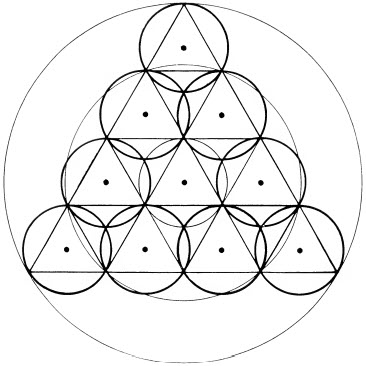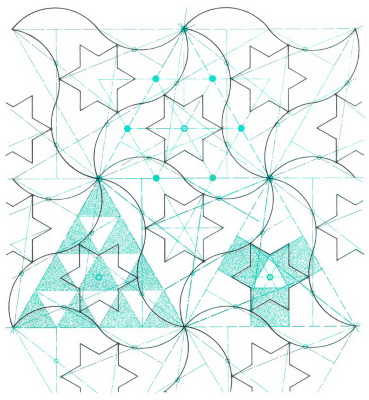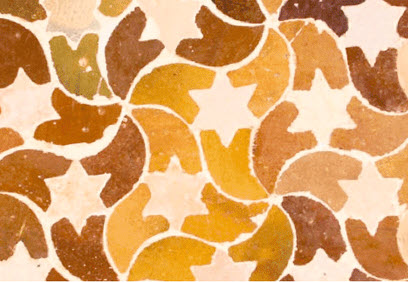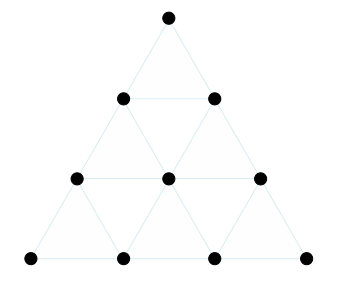
Tetractys
The tetraktys is a mystical and philosophical symbol of ancient Greece, represented by a series of ten points arranged in the shape of a pyramid, with four rows of one, two, three and four points respectively.
The Tetraktys is considered a sacred symbol in Pythagorean philosophy and symbolizes harmony and mathematical perfection.
The duple progression (1 2 4 8) represents “the evolution of the vehicle” proceeding out of Unity, that is, the differentiation and division that constitute the physical body. The triple progression (1 3 9 27), in the order of involution (27 9 3 1), represents “the development of consciousness” as a return to unity.
Contents
- 1 Tetractys
- 2 Who created tetraktys?
- 3 What was the perfect number for Pythagoras and what relationship does it have with tetraktys?
- 4 Tetraktys and Pythagorean musical harmony
- 5 Content related to Tetraktys
- 6 The tetraktys and the sacred geometry of Islam
- 7 Tetraktys Related Symbol
- 8 Tetraktys applied to the design of a tile from the Alhambra
Who created tetraktys?
Tetraktys was a concept developed by the Pythagoreans, an ancient Greek philosophical and mathematical school, founded by Pythagoras of Samos.
It is considered one of the most important and sacred symbols of its philosophy and was used in the teachings and rituals of the Pythagorean school.
What was the perfect number for Pythagoras and what relationship does it have with tetraktys?
For the Pythagoreans, the perfect number was the number 10.
The Pythagoreans considered that 10 represented perfection and harmony in the universe, since it was made up of the first four numbers (1, 2, 3 and 4) which together result in precisely 10.
The tretraktys is precisely the representation of the number 10 through its pyramid-shaped arrangement.
Furthermore, it arises from the sum of the numbers 1, 2, 3 and 4. Each of these numbers has a meaning from the Pythagorean point of view.
What does 1 mean for the Pythagoreans?

The 1 represents unity, the origin of all things and divinity. However, the Pythagoreans distinguished 1 as a number from “the One” as a supreme unit, which they called “monad.”
What does 2 mean for the Pythagoreans?

The two, called dyad, represents duality, with its different manifestations masculine-feminine, light-dark,… When the point that moves gives rise to a straight line, which symbolizes the duality of beginning – end.
What does 3 mean for the Pythagoreans?
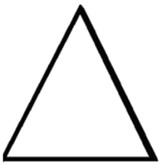
The 3 refers to the triad. It is the plane, the triangular geometric figure. It represents the odd and everything that is harmonious to the “monad”, harmony, moderation.
What does 4 mean for the Pythagoreans?
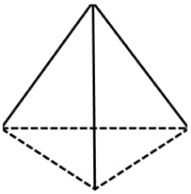
The 4 symbolizes the four elements: water, earth, fire and air. It is the representation, therefore, of the material world, and is called a “tetrad.” It contains everything material and immaterial in “time” and “space”, it is what reality appears in its entirety.
Tetraktys and Pythagorean musical harmony
If we arrange the points of the Tetraktys in the shape of a right triangle we obtain a figure like this, which is already found in Theon of Smyrna and Nicomachus of Gerasa:
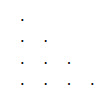
This arrangement is at the origin of the musical scale of the Pythagoreans, and gives rise to the arrangement of the strings of the tetrachord of Philolaus, Pythagorean philosopher and music theorist.
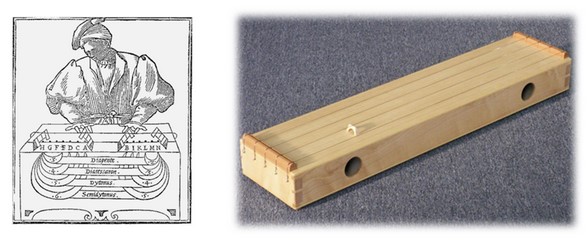
The tetrachord of Philolaus was the transformation of the monochord into a four-stringed instrument.
Philolaus divided the rope into two, three and four parts, that is, the four numbers of the Tetractis. and from these intervals he constructed the musical harmony according to the proportions
1/1 – 1/2 – 2/3 – 3/4
The numbers indicated the ends of the two points fixed on a rope that had been tensioned. These points corresponded to numbers marked on a graduated axis that ran beneath the rope itself.
Following this procedure, Philolaus obtained the instrument known as a tetrachord.
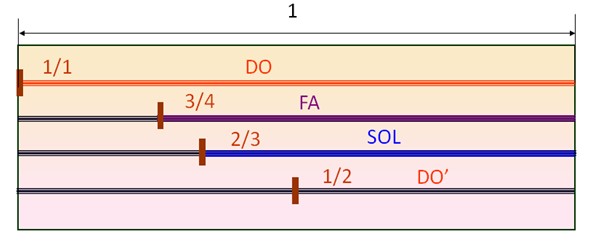
The arrangement and use of the tetrachord was as follows:
Let’s play the first string (without any bridge), thus making the first note that we will call C resonate.
On the second string we place a bridge in the middle of its length. Let’s play the second: it corresponds to the same starting note but higher and we will call it Do’.
On the third string we place a bridge 2/3 of its length. Let’s play the third string. We will call this note Sol.
On the fourth string we place a bridge 3/4 of its length. Let’s play the fourth string. We will call this note Fa.
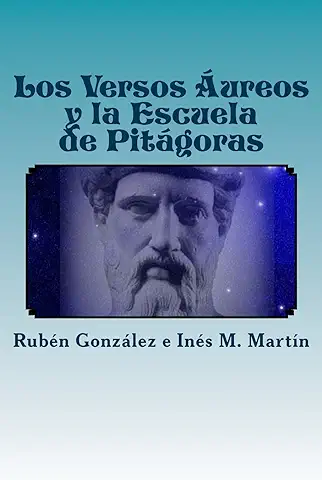
Translation from Greek of “The Golden Verses” attributed to Pythagoras, a set of maxims that contain a way of living based on ethical, psychological and spiritual principles and that was applied in the Pythagorean School and its successors.
The tetraktys and the sacred geometry of Islam
The symbol of the tetraktys and the philosophical concepts associated with it were collected by Plato in his work The Timaeus. From there it reached the Islamic philosophers, particularly the Persian philosopher Suhrawardi.
According to some Islamic authors, the wisdom contained in the tetraktys was also transmitted by the craft guilds through the geometric patterns of the tiles. These teachings were also related to Hermeticism. (Source: Islamic Patterns. An Analytical and Cosmological Approach Keith Critchlow)
Tetraktys Related Symbol
According to Islamic authors, the teachings transmitted by Islamic artisans through the geometric patterns of their designs would also be related to Hermeticism. Let us remember that the symbol of Hermeticism is the rod of Hermes or Caduceus.
And this is the reason why the geometric scheme of the tetractys appears in many of the geometric designs of Islamic art. In this design, the equilateral triangle with 4 points per side is essential, and the importance of 3 and 4.
Tetraktys applied to the design of a tile from the Alhambra
Let’s look at the example of the tetraktys scheme, on which some variations are made, which are finally applied to the design of one of the tiles that we can admire in the Alhambra in Granada, one of the jewels of Islamic art.
